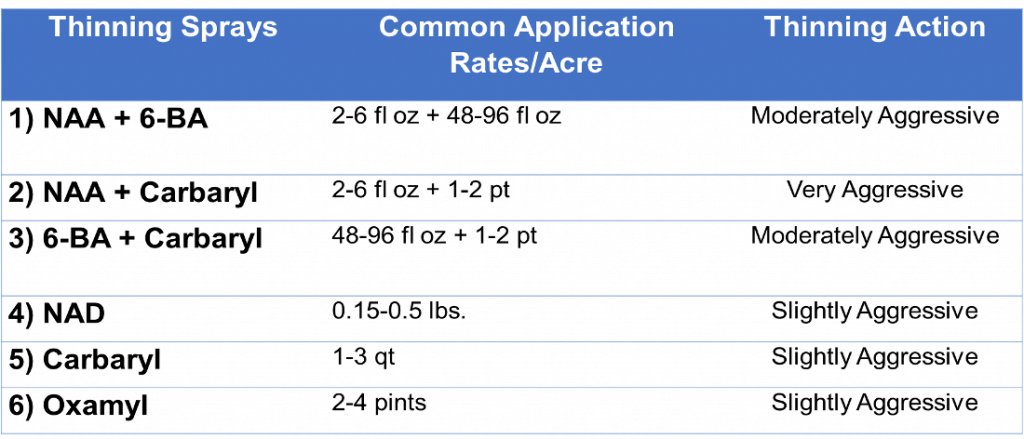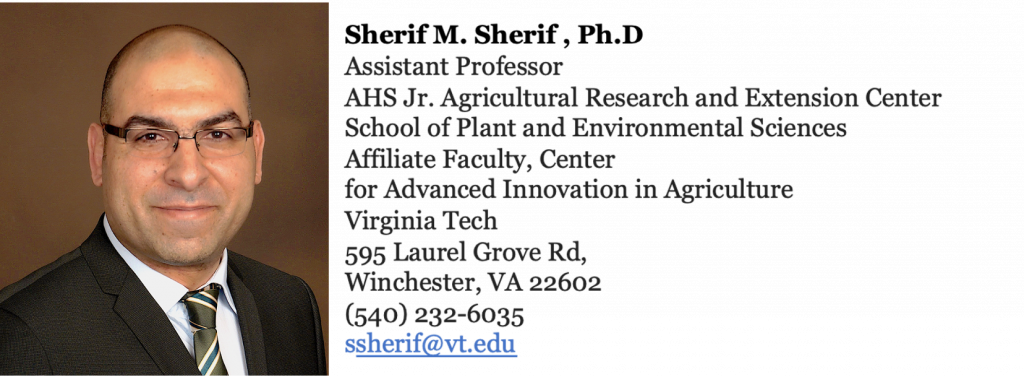After all the frost events and subfreezing temperatures in the past four weeks, we (the state of Virginia) still have a medium-heavy apple crop, and we should start planning for the fruit thinning treatments. However, given the geographical distribution of apple orchards throughout the state, which results in different developmental stages, growing degree days, elevation, etc., thinning recommendations would vary from one location to another. So, this post aims to give a general overview of thinning materials, rates, and application timing as well as a few suggestions to consider when thinning certain cultivars or using specific materials. But I will follow this with other blog posts focusing on particular locations as required.
Table 1: Common chemical thinners, tradenames, and manufacturers.

- Notes
- Exilis 9.5 SC contains 9.51% of 6-BA, compared to 1.9% in Maxcel and 2% in Exilis Plus.
- There are two forms of Refine; Refine 3.5 and Refine 6.25. The later contains a higher concentration of NAA.
Table 2: Effective thinning sprays at petal fall to 5 mm fruit diameter

Table 3. Thinning materials and rates for 6-18 mm fruit diameter

- Do not use NAD and NAA with Red Delicious or Fuji, as this will result in pygmy fruits.
- To achieve better results with NAD, use it in 100 gallons or more per acre.
- Carbaryl can be used alone for fruit thinning between petal fall and 15 mm fruit diameter. However, it is better to combine it with either NAA or 6-BA for thinning fruits at 7-15 mm.
- Carbaryl is not rate-responsive when used alone, so increasing the rates of carbaryl will not necessarily improve thinning efficiency.
- 6-BA enhances cell division and fruit size compared to other fruit thinners. Therefore, it is recommended to use it when thinning small-fruited cultivars such as Gala and Ginger Gold.
- Temperatures between 75 – 85 oF are ideal for 6-BA uptake and effectiveness. 6-BA is not effective when temperatures are below 68°F.
- NAA can reduce the overall fruit size of the harvested crop compared to other chemicals used in fruit thinning.
- NAA applications for fruit thinning can also enhance return bloom in biennial bearing cultivars, such as Honeycrisp and Golden Delicious. Research from my lab at Virginia Tech showed that NAA applications within the first 30 days of bloom are critical for flower bud formation and return bloom. NAA applications at 40 and 50 days of bloom have minimal effect on return bloom in Honeycrisp.
- Adding a non-ionic surfactant (e.g. Regulaid @ 1pt/100 gal) to 6-BA and NAA spray mixtures improves thinning efficiency.
- We use the Cornell Apple carbohydrate thinning model on the NEWA website (https://newa.cornell.edu/apple-carbohydrate-thinning) to determine the optimal timing for thinning treatments. The model collects temperature and solar radiation data from the nearest weather station to your location to predict the carbohydrate status of the tree. Under the carbohydrate deficit status, trees become more responsive to thinning treatments; and the opposite is true under the carbohydrate surplus conditions.
- Sunny, cool days and cold nights promote carbohydrate accumulation, resulting in low thinning efficiency; whereas cloudy, hot days, and warm nights lead to carbohydrate deficiency, which is good for fruit thinning.
- The upper parts of the canopy are harder to thin than the lower parts.
- If you have a heavy crop, thinning will be easier than having a light crop.
- Vigorous trees are harder to thin compared to compact and dwarf trees.
Table 4: Effective thinning treatments at 16 mm-25 mm fruit diameter.

- Ethephon should be applied as a “rescue thinning” treatment if first thinning sprays were insufficient. It is most commonly used when fruit size is between 18 and 26 mm.
- When aggressive thinning is needed, mix carbaryl or NAA with ethephon.
- Ethephon can result in severe over-thinning, particularly at high temperatures (> 90 oF).
- Accede, a new thinning product from Valent USA, can also be used at this stage. For more information about Accede, read our blog post: https://blogs.ext.vt.edu/tree-fruit-horticulture/?s=Accede
Table 5: Easy, moderate, and hard to thin apple cultivars.

Disclaimer
Application rates mentioned in this article are based upon a concentrate spray volume of 100 gallons per acre and product labels at the time of publication. When applying chemical thinners use the rates indicated on the labels of the products that you are using. The degree of thinning action are listed according to the author’s personal field experiences. The degree of thinning action may vary from orchard to orchard and block to block.
For more information regarding apple fruit thinning, you can read our extension pub “Crop Load Management in Commercial Apple Orchards: Chemical Fruit Thinning” at https://www.pubs.ext.vt.edu/SPES/SPES-134P/SPES-134P.html.

